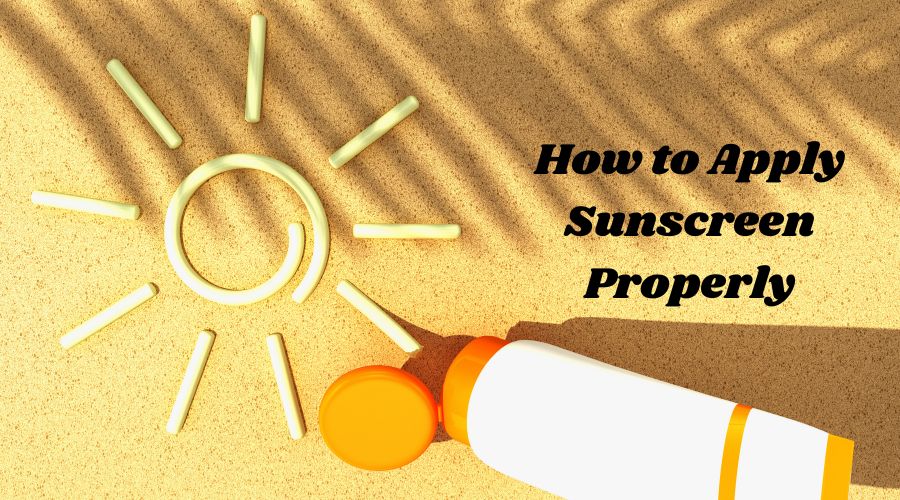
Are you using enough sunscreen while you practice skin protection? Is applying sunscreen done correctly? In all likelihood, the answer to both these questions might be 'No'! The specialists state that few people understand how to use sunscreen or do not use enough sunscreen. For example, a survey by the American Academy of Dermatology found that while 80% of the respondents understood that they need to reapply sunscreen often when outside, few do it.
Before proceeding, remember how sunscreen should be applied and its importance. This article aims to safeguard you against the sun's ultraviolet rays throughout the year.
To begin with, it will be helpful to determine which areas of your skin will be more exposed to the sun after applying or reapplying sunscreen. Think about it: Your face, neck, and the back of your hands could be exposed to sunlight even as you are indoors or even while driving your car, whereas your body is occasionally exposed to the sun and other elements as you go about your daily activities. So, it is possible to divide sunscreen application into using the product on the face and neck and sunscreen on the rest of the body.
The amount of sunscreen that should cover your face is equivalent to two finger lengths from the tip of your index finger. This means that if you rub sunscreen on the palm of your hand and then run your hand down the length of your index and middle fingers, that is the right amount.
Do not neglect the very top of the ears and other areas that people usually overlook, such as a little bit above the cheeks or the sides of the face. You should use more if you need to cover the scalp or other areas of the body other than the face.
Which should be applied first, the moisturizer or the sunscreen?
Whether the sunscreen is chemical or physical, it should be applied as the final step. Therefore, if you are used to applying moisturizer to your skin, this should be done before applying sunscreen.
Is it safe to moisturize the skin and skip the sunscreen?
It's best that you do not, mainly if you live in a region with low humidity, say January or February. As for choosing the right type of makeup or any other product with SPF, you only need to ensure you have the right protection with a proper SPF level. You should apply SPF 30 daily for your skin to be adequately protected.
What is the procedure if I want to apply makeup over sunscreen?
First apply sunscreen and apply makeup afterward. Furthermore, if you are exposed to sunlight or going out for an extended period, you can always buy tinted sunscreen lotion.
As far as your body is concerned, it is advisable to use approximately enough sunscreen to cover a shot glass that holds 1 ounce in all areas of the skin exposed to the sun, for instance, after undressing to put on swimwear. Using much of it is wiser since the sunscreen's protection is diminished if one applies little and thinly. One drawback of spray sunscreen is that it is difficult to determine how much you use on your skin. Spray sunscreen has to be applied to the skin for protection, not just sprayed over the skin and then left.
Do not spray the product closer to the skin than 2 inches; use it liberally and widely until the skin area targeted by the spray glistens. After applying a spray sheen to a particular portion of the body, it is necessary to massage it to allow it to penetrate the skin and then reapply after time intervals.
Is it necessary to apply sunscreen every day?
You should always wear sunscreen because there is always a possibility of coming into contact with sunlight one way or the other. This does not necessarily mean that you should use sunscreen only when it is sunny; the sun is always bright and has its dangerous rays whether it is sunny or not.
As per the time within the day you put it on, it is recommended that sunscreen should be applied 15 minutes before exposure, such as before going out of the house. When out in the sun, you should be reapplying:
Is using a sunscreen product with SPF 30 or SPF 50 more effective?
The SPF number indicates how many minutes skin would usually burn under regular sunlight with the correct amount of sunscreen applied as suggested on the label—without sunscreen. This means that if sunscreen is applied correctly, for instance, SPF 30, it would take 30 times longer to burn than if you were not using sunscreen.
However, there are a few things that one should note here. This timeframe depends on the individual skin type; those with lighter skin types, such as fair skin types, might get burnt much faster than others. Furthermore, many people fail to use enough sunscreen, either in proportion or how often it is applied. Therefore, one needs to use sunscreen as directed by the manufacturers on the containers of the particular brand.
One must choose a sunscreen that is acceptable to the skin and comfortable to use; guess what? Using no sunscreen is not an option! Regardless of the weather, be it a rainy day, a sunny day, or even a cloudy day, it is always recommended that sunscreen be the final thing applied to the skin.
Until you select the right skincare products, it is almost impossible to achieve accurate results. Many p...
READ FULLSkin toners offer several benefits for your complexion. They help to remove any remaining traces of dirt, o...
READ FULLTo open a cosmetic shop is not as easy as filling the shelves with some beautiful items. It is all about th...
READ FULL